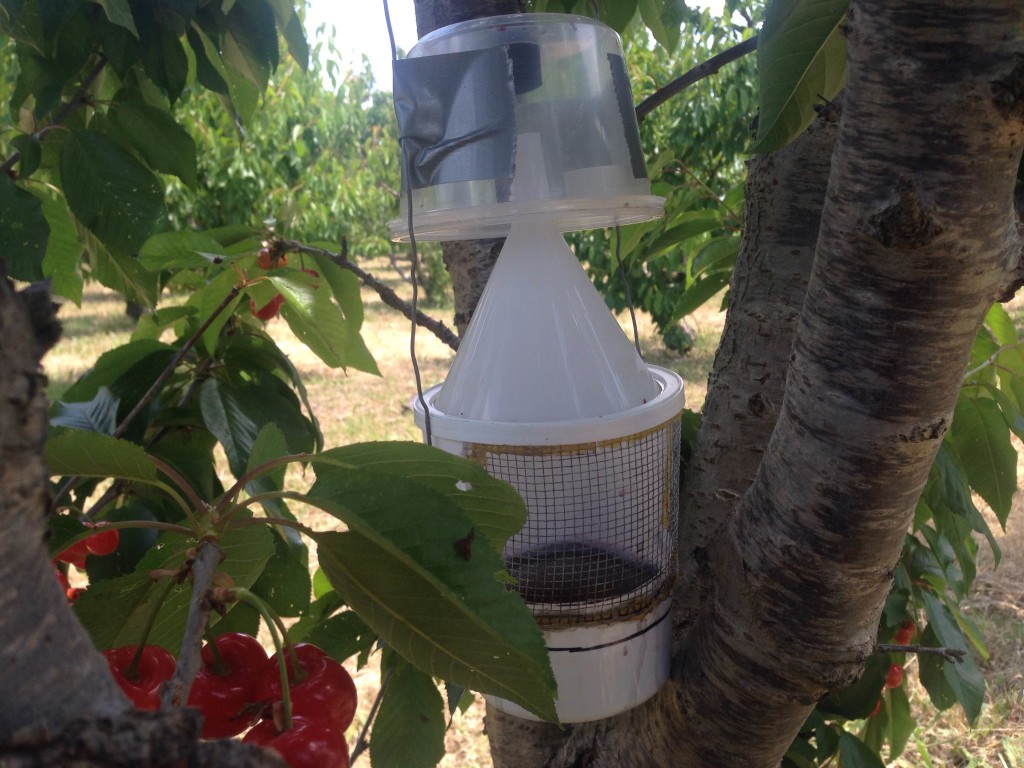In 2008, California’s farms were struck by a plague – the Spotted Wing Drosophila. For the first time this little creature took flight over the contiguous United States. In it’s wake, it left millions of dollars of crop damage.
First found on the Central Coast of California, the Spotted Wing Drosophila spread through the entire West Coast within the span of a single growing season – a feat previously unheard of for any invasive pest. In the studies done since, researchers found that this single creature may have caused as much as $500 million in revenue losses that year.
So what exactly does this tiny fly, not too distantly related to the fruit flies that fill your kitchen, do to damage so much fruit? The answer is really two part. First, It lays its eggs in ripening fruit, esp small dark colored fruit including berries and cherries. Unlike the fruit flies in your house, it’s not attracted to over ripe fruit, but the young undamaged fruit. This is a critical distinction from it’s native competitors. The female Spotted Wing Drosophila lays her eggs in the fruit through a tiny, almost microscopic puncture in its flesh. This makes the damage virtually undetectable until the fruit begins to rot when the eggs hatch and the larva feast away. Secondly, the rapid lifecycle of the Spotted Wing Drosophila means that this process occurs very quickly and at massive scale. The adult SWD lives for about two weeks, and can lay more than 100 eggs in a day, meaning that a single fly can impact 100s of trees in it’s lifetime. And, Spotted Wing Drosophila populations can have as many of 10 generations a year.
Thankfully, the response from the West Coast the agricultural science community was swift. The University of California, Oregon State University, Washington State University and the USDA joined forces to demystify this new threat and outfit farmers with the tools they needed to manage it. Within a year of research, they had largely eliminated the once catastrophic threat posed by Spotted Wing Drosophila by providing farmers with the right educational and biological tools. Teams of entomologists across all three states worked with nearby farms to trap fly specimens, determine their lifecycle, their ideal environment, and how to reduce their populations.
Frog Hollow was one of the first farms to join in on the study and offering critical data from the very beginning. Al was asked to participate by Dr. Janet Calipri, who’s heading up the local Contra Costa research. He was eager to help. As a junior in college at UC Berkeley, Al studied another Drosophila species as part of a genetics class. They were able to effectively watch evolution in action as they studied how it’s rapid reproduction cycle allowed the fly to adapt to it’s environment with comparatively lighting speed. 50 years later, watching this same process in his orchard he understand how real of a threat creatures with such adept adaptability could pose.
In the years since the study began, Dr. Calipri and other scientist across the coast are refining their research to offer better and better resources for farms. The mounting focus of their research at this point is on watching Spotted Wing Drosophila populations to see if they are developing resistances to the sprays developed to limit growth. Scientists have developed a number of sprays for conventional growers, but organic farms like have very limited options. There is but one biological spray which has been demonstrated effective. It’s called Spinosad. Spinosad is a natural substance made by a soil bacterium that is toxic to Drosophila. Because organic farmers are currently reliant on a single material for limiting population growth, they are at serious risk of the Spotted Wing Drosophila developing resistance, leaving growers near defenseless.
That said, things are not quite as dire as they may sound. Here at Frog Hollow we’ve faced almost no damage as a result of the Spotted Wing Drosophila. Al attributes this in large part to our remarkably resilient soil, supported by booming microorganism populations, thanks to our compost. I think he’s just unphased by it all. When you’ve been farming for 40 years, you learn to roll with the punches; namely an unceasing onslaught of pests, diseases, weather phenomenon, misguided government regulations and more. Ultimately, the moral of this story is that farming, esp organic farming, is not for the faint of heart, mind or spirit. So next time you take a bite of your favorite peach, kale salad, or grass fed steak, say a little thank you to the fearless men and women to bring it to your table.

 Follow
Follow

